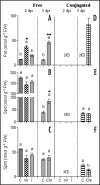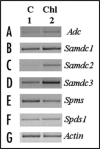Ustilago maydis induced accumulation of putrescine in maize leaves
- PMID: 19794848
- PMCID: PMC2664492
- DOI: 10.4161/psb.4.4.8089
Ustilago maydis induced accumulation of putrescine in maize leaves
Abstract
Polyamines are implicated in the regulation of many processes in the plant cell, including functioning of ion channels, DNA replication, gene transcription, mRNA translation, cell proliferation and programmed cell death. Plant polyamines occur either in free form, covalently bound to proteins, or conjugated to hydroxycinnamic acids forming phenol amides. Ustilago maydis is a dimorphic and biotrophic pathogenic fungus responsible for common smut or “huitlacoche” in maize; and it is considered an excellent model for the study of plant-pathogen interactions. Recently, we reported alterations in polyamine metabolism of maize tumors induced on leaf blades by Ustilago maydis infection. Our data revealed a striking increase in maize polyamine biosynthesis, mainly free and conjugated putrescine in the tumors and in the green plant tissue surrounding the tumor. In this addendum, we describe that changes in polyamine metabolism take place even in earlier stages of maize plant infection with Ustilago maydis.
Keywords: Ustilago maydis; Zea mays; early stages; polyamines.
Figures


Comment on
-
Polyamine metabolism in maize tumors induced by Ustilago maydis.Plant Physiol Biochem. 2008 Aug-Sep;46(8-9):805-14. doi: 10.1016/j.plaphy.2008.05.012. Epub 2008 Jun 4. Plant Physiol Biochem. 2008. PMID: 18614373
References
-
- Takahashi Y, Berberich T, Yamashita K, Uehara Y, Miyazaki A, Kusano T. Identification of tobacco HINI and two closely related genes as spermine-responsive genes and their functional expression during the Tobacco mosaic virus-induced hypersensitive response and during leaf- and flower-senescence. Plant Mol Biol. 2004;54:613–622. - PubMed
-
- Uehara Y, Takahashi Y, Berberich T, Miyazaki A, Takahashi H, Matsui K, et al. Tobacco ZFT1, a transcripcional repressor with Cys2/His2 type zinc finger motif that functions in spermine-signaling pathway. Plant Mol Biol. 2005;59:435–448. - PubMed
-
- Walters DR. Polyamines and plant disease. Phytochem. 2003a;64:97–107. - PubMed
-
- Walters DR. Resistance to plant pathogens: possible roles for free polyamines and polyamine catabolism. New Phytol. 2003;159:109–115. - PubMed
-
- Kakkar RK, Rai VK. Plant polyamines in flowering and fruit ripening. Phytochem. 1993;33:1281–1288.
Publication types
LinkOut - more resources
Full Text Sources
